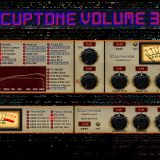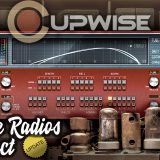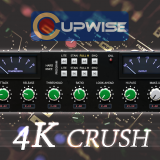There’s almost surely some things I’m forgetting here, but these are probably all of the major updates.
- new skins allow you to press LED buttons on the skins to switch between the programs. this really improves the experience; especially with the LFO programs where you can select different LFO shapes with the push of a button. there are 3 separate skins. one is for the EQ boost/cut, bandpass, notch, and pass-through programs. another skin has the LFO programs, and the last skin has the envelope follower effects.
- it’s now called Yourei EQ/BP/N v2
- i made the ability to use this release as an EQ a more up-front focus of this release. the peak boost and cut ability is easier to access and use than they were in the old release (you could use the programs for these purposes but it was really finicky to set up for the boost). the original hardware didn’t offer these (it only has bandpass and notches), i made them by combining the bp and notch samples with the pass through samples, which allows us to have some really nice peak and cut bands for EQing purposes. these are probably the most commonly useful things you can do with the programs in this release so they have been made a focus. It’s a really nice sounding boost or cut that can be placed anywhere in the frequency response.
- the low end ripple that happened as a result of truncated impulses has been removed. there is some subtle ripple that appears if you have a sharp filter at low freqs, but that is seen on the hardware too, so it’s accurate.
- 48 and 88.2khz sample rates were added.
- many of the programs combined the 3 filter types (notch, bandpass, peak) into one program, allowing access to all 3 in the one program. that sounds good but it drastically increased load times (due to having to load the samples for modes you might not even need), and the knob to switch between the modes worked in a confusing and not very good way. now the notch, bandpass, and peak all get their own separate programs, which allows some programs load faster. not having them all in one program is no loss because the new skin has buttons that you can use to switch to whatever mode you want. this is actually a really big improvement in terms of organization and usability.
- all programs load at least a little faster than before. some load a lot faster. the main notch program still takes several seconds to load on my older PC, but it has almost 3,000 samples and there’s no way to make it load faster.
- LFO/envelope programs have smoother motion because i’m using a faster program rate. this isn’t as noticeable at slower modulation speeds but it sounds more authentic to analog modulation (like you’d get in a modular synth for example) at faster rates, especially with the 96khz programs. this does require slightly more CPU compared to the original programs, but i put those out over 10 years ago! the notch at its widest setting sounds like a nice and smooth phaser.
- the LFO width control works in a better way now. the % you set it to will always cause the LFO to travel that % of the way, between where you set the base frequency, and the maximum frequency. this means the LFO will never ‘peg out’ at the highest frequencies, like it could in the past with some settings. kind of hard to explain but it’s just better this way.
- the envelope follower programs are more useful now. in the past there was a bug (this was actually due to a bug in nebula itself), where the ‘attack’ would usually always be instant. you wouldn’t actually be able to get the filter to smoothly slide up (or down) during the attack, before returning for the release. it would just kind of jump to the highest (or lowest) point, then slide back for the release. now you can actually get slower attacks. this really opens these up as nice little auto-wah effects. these also got a threshold control now which gives you an easy way to control how much ‘travel’ the filter does.
- evened out the levels of the bandpass/peak filter across the range. they’re still not exactly the same at all settings but neither was the actual gear. You probably never noticed the levels being uneven in the past because it was usually subtle, but it is improved now.
- removed the external sidechain envelope follower programs because for whatever reason, years ago, Acustica removed the ability to introduce an external sidechain into Nebula.
- feedback is only found in BP modulation (or the for automation) programs, because it’s just not good in the notch and peak programs. the reason is because those programs have the entire frequency response in them, and all of it gets fed back, which just gives you a comb filtering effect. with the bandpass programs only the audio around the cutoff gets fed back.
- the tone programs have been updated to match the updates i gave them for the ‘Cuptones Vol 1’ release, which includes cleaner harmonics and reduced artifacts.
- new manual.














